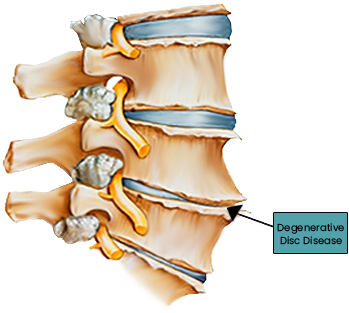What is Degenerative Disc Disease?

Degenerative disc disease is when changes occur in the spinal discs as you age. When we think of spinal discs, we like to think of them as shock absorbers between your spine. These shock absorbers allow for flexibility as you twist and bend. As we age, signs of wear and tear occur as they begin to break down. Eventually, they will not perform as well.
As a matter of fact, almost everyone’s disks break down over time. However, not even will feet pain. If worn down discs are the reason for pain, then you have degenerative disc disease.
Causes of the Disease
Spinal discs contain a soft gel-like inner core and a tough outer shell. Our disks change in ways that cause degenerative disc disease, such as:
Cracking. Over the years, the stress can cause tiny tears in the outer wall that contains nerves. And when tears happen, nearby nerves become painful. Sometimes, the walls break down and the disks soft gel-like core might bulge through the cracks. When a disc bulges, this is called a slipped or a herniated disc.
Drying out. This may come to a surprise, however, when we are born our disks are made up of mostly water! Then, as you age they gradually lose water and become thinner. When water is lost though, it allows for less of a cushion between the vertebrae. And eventually, this leads to spinal problems, causing pain.
Symptoms of Degenerative Disc Disease
Degenerative disc disease patients usually experience constant sharp pain in the neck or back. However, depending on where the weakened discs are will also determine the signs.
Common signs, such as:
- Is in your lower back, buttocks, or upper thighs
- Comes and goes. It can be nagging or severe and can last from a few days to a few months.
- Feels worse when you sit, and better when you move and walk
- Feels worse when you bend, lift, or twist
- Gets better when you change positions or lie down
Treatment for the Disease
Conservative treatment methods are first explored unless of course, the disease is severe. The main goal of this treatment is to ease pain and stop any further damage. The physician will go over what the best treatment plan is for your disease. However, these treatments may include:
Medication. Over-the-counter pain relievers like aspirin and ibuprofen can help fight inflammation. They can ease your pain and lessen swelling. Your doctor may prescribe a stronger drug for pain if you need it.
Physical Therapy. Specific movements make the muscles in your neck and back stronger and more flexible. This supports the spine. Sometimes, this may even be enough for long-lasting relief.
Steroid Injections. Steroid shots are a strong medication that eases swelling and inflammation. Sometimes, a doctor may suggest an epidural space injection.
Surgery. When conservative methods fail, your doctor may suggest surgery. One procedure, called a discectomy, removes the injured part of the disk. This helps take the pressure off your nerves.
Although, in some cases, your doctor might remove the whole disk and put an artificial one in. If you have a severe problem, your doctor might fuse (permanently connect) the bones in your spine after he removes the disk.
If you suspect degenerative disc disease or would like to explore different treatment options for back pain, our Top Spine Doctor in Boca Raton has got your back! Call us at 888-409-8006
